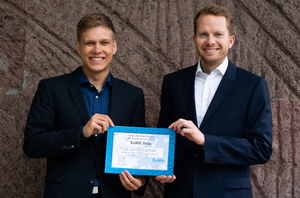June 22, 2022
Scientists from the departments "Photonic Networks and Systems" and "Photonic Components" of the Fraunhofer Heinrich Hertz Institute (HHI) are the winners of this year's European Microwave Integrated Circuits Conference (EuMIC) Prize. The research team received the award for their paper "120 GBd SiGe-Based 2:1 Analog Multiplexer Module for Ultra-Broadband Transmission Systems." In this paper, Fraunhofer HHI’s photonics experts present the Analog Multiplexer Module jointly developed with researchers from the University of Stuttgart.
After being postponed several times due to the pandemic, the 16th EuMIC conference took place in London on April 3-4, 2022, as part of the European Microwave Week (EuMW). It is the most influential European conference for high-frequency and microwave electronics as well as optoelectronics. Aiming to present the latest innovations in the industry, the conference promotes scientific exchange and transnational networking. Within this framework, the awarding of the EuMIC Prize for the best research paper marks a reputable highlight.
The Fraunhofer HHI department "Photonic Networks and Systems" develops solutions concerning high-performance optical transmission systems. In addition to increased capacity, the project’s research scope addresses improved security and energy efficiency. In this context, Digital-to-Analog Converters (DAC) with remarkably high conversion rates and bandwidths are of particular interest for optical transmission. For instance, wavelength division multiplexing techniques for data rates above 100 Gbit/s use DACs combined with digital signal processors on the transmit side. The rewarded paper addresses inherent challenges by illustrating concrete applications that generate electrical signals at ever-higher symbol rates.
Fraunhofer HHI's Analog Multiplexer Module contains a chip collaboratively designed with the University of Stuttgart. The module permits two channels of a DAC to be merged into one single channel with a significantly increased data rate. Such a setup allows to generate signals with up to 120 billion symbols per second (120 GBd) at 2 bits per symbol, equaling 240 gigabits per second net data rate and 60 GHz of bandwidth. With the new module, Fraunhofer HHI’s photonics experts elucidate that a transmitter's data rate and bandwidth can be significantly increased in communication systems while maintaining cost-efficiency. Accordingly, excellent research and innovation in this area foster the critical infrastructure for emerging information and communication applications.
Dr. Christian Schmidt, Dr. Jung Han Choi, Christoph Caspar, Detlef Pech, Sebastian Wünsch, Greta Ropers, Jonathan Schostak, Prof. Volker Jungnickel and Prof. Ronald Freund were involved in the research project on behalf of Fraunhofer HHI. For the University of Stuttgart, Tobias Tannert, Dr. Markus Grözing and Dr. Manfred Berroth contributed to the project.
Read more about the research topic here .
